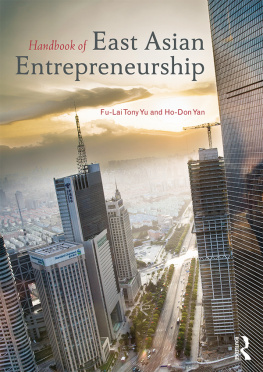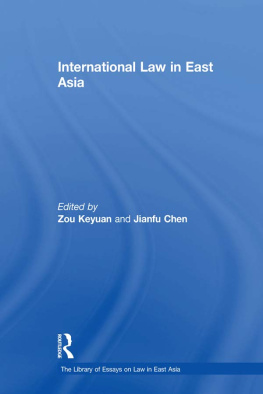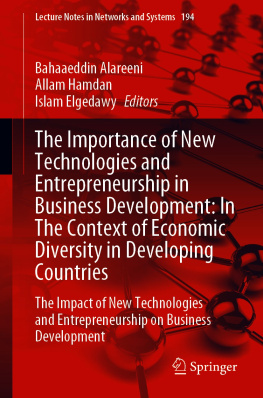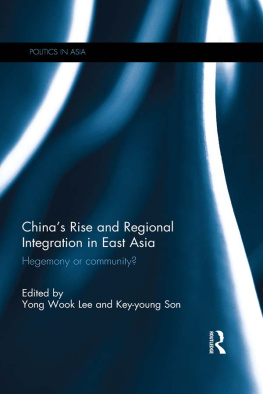Fu-Lai Tony Yu and Ho-Don Yan
The gravity of the world economy is shifting toward emerging economies. According to the International Monetary Fund (IMF) (2012), the GDP weight of emerging and developing countries has jumped from 30 percent in 1990 to 48 percent in 2010 in just 20 years. Global foreign direct investment (FDI) flows have been teetering toward the developing world as well. In 2012, the United Nations Conference on Trade and Development (UNCTAD) (2013) reported that developing countries absorbed more FDI than developed countries for the first time ever, accounting for 52 percent. McKinsey Global Institute (MGI) also estimated that by 2025 annual consumption in emerging markets will rise to US$30 trillion, up from US$12 trillion in 2010, and will account for nearly 50 percent of the worlds total, up from 32 percent in 2010 (Atsmon et al. , 2012). How emerging economies, particularly China, can grow so fast in so short a period of time has become the interest of study on the development economics and growth strategies for catching-up, such as import substitution, big push, and flying-geese theories (Radelet and Sachs, 1997) over the past half-century, and the recent new structural economics (Lin, 2012a).
The economic growth theory, chiefly designed for developed countries that have a similar industrial structure and technology capability, predicts that lower-income countries eventually will converge or catch up to higher-income countries (Solow, 1956; Barro, 1997). For most emerging and developing economies with the disadvantage of backwardness in their technology, the growth model postulated by mainstream economics, either the neoclassical or new classical growth models, is unsuitable (Lin, 2004). Given the co-existence of advanced and backward nations, the latter could skip several stages that the former had to go through by adopting the advanced technologies of the former as Gerschenkron (1962) argued. Lin (2004) postulated that latecomer nations can turn this backwardness into an advantage by adopting a competitive advantage-following strategy, in lieu of a competitive advantage-defying strategy. Emerging economics can benefit from developing labor-intensive production and borrowing incumbent and tested technologies invented by advanced countries. As observed by the World Bank (2008), though developing countries lack advanced technological competencies, technological progress can occur through the adoption and adaptation of pre-existing but new-to-the-market or newto-the-firm technologies.
Apart from the national level of the above-mentioned growth strategy, it is important to investigate the growth strategies from the firm level. After all, the creation of a nations wealth consists of the summation of each individual firm. However, the intellectual tyranny of the neoclassical firm theory over-emphasizing efficient resource allocation comes at the cost of assuming that goods and services are given and the economy becomes production-less (Coase and Wang, 2011; Coase, 2012). A production-less economy overlooks the importance of the role of clever ruses, ingenious schemes, and brilliant innovations of the outstanding entrepreneurs who dedicate themselves towards product development and the organization of production. Indeed, the gathering pace of globalization and the convergence of the trio of information, communication, and technology have intensified competition and simultaneously democratized entrepreneurship at a cracking pace. Entrepreneurs have been touted as global heroes, and entrepreneurship is an indispensible component of growth and prosperity (Bygrave and Zacharakis, 2008: 1; The Economist , 2009; Wright and Zahra, 2011).
Like the growth theories on the macro-level, from the perspective of the firm level, the research paradigm of entrepreneurship studies is inherently based on developed economies, in which the focal emphasis is how to lead the market through creative innovation and dominant market strategies (Hobday, 2000). As latecomer firms lag behind in knowledge of technology, marketing, and management, it is hard for them to compete head-to-head with the multinational corporations (MNCs) of advanced economies. Instead, over the past four decades, many successful latecomer firms wanting to upgrade their technology normally followed a catch-up path. First, they start practicing original equipment manufacturing (OEM), which is making products that are sold abroad and bear the brand name of another company (mostly MNCs), as a way to link to the global production network and to learn new technologies, managerial skills, and global market practices (Hobday, 1995; Mathews, 2002; Yan et al. , 2014). An OEM strategy could help accumulate a large amount of wealth and capabilities for firms, thereby helping to transform OEM firms into establishing their own brand manufacturing (OBM), which is producing and selling products with the firms own brand, and this requires more innovation-driven business practices. Many latecomer firms have gone through this transforming process and eventually forge ahead of those MNCs from advanced economies. Examples include Sony, Toyota, and Samsung, to name but a few.
The unusual speed of technological progress in post-war East Asian countries (Japan, South Korea, Taiwan, China, and Hong Kong) has been praised as a good example of the catching-up growth model (Page, 1994; Hobday, 1995; Mathews, 2002; Lin, 2004). The implications of the East Asian catching-up experiences are profound and have become an active area of investigation. East Asia has heterogeneous capitalism structures, with Hong Kong as a nearly complete laissez-faire market economy and the other four economies marked under different types of government-directed capitalism (Baumol et al. , 2007). Taiwan is noted for its abundant small and medium-sized enterprises (SMEs), South Koreas economy is dominated by business conglomerates ( chaebols ), Japans businesses are known for industrial networks ( keiretzu ), and China is replete with emerging multinational manufacturers. There have also been different levels of economic development within the region, not to mention large differences in population, culture, industrial structures, and economic policy. However, a common feature shared by these five economies is that they all either have experienced or are experiencing rapid catching-up growth. The sequential, yet in-tandem growth pattern of the East Asian region is known as the flying-geese, led by Japan, followed by South Korea, Taiwan, Hong Kong, and Singapore, and with China as the tail (Akamatsu, 1962; Ozawa, 2009). Through technology dissemination and emulative learning, East Asian countries sequentially and successfully have built their skills and upgraded their industrial structures.
What is the role of entrepreneurship in the catching-up growth strategies? Variant entrepreneurial activities are defined, such as in Kirchhoff (1994) and Wenneker and Thurik (1999), among others, and entrepreneurial behavior can be divided into two types: adaptive entrepreneurship (or Kirznerian entrepreneurship) and revolutionary entrepreneurship (or Schumpeterian entrepreneurship) (Yu, 2001), or are similarly known as replicative entrepreneurship and innovative entrepreneurship by Baumol et al. (2007). The former refers to opportunity discovery focusing on those producing or selling a good or service already available through other sources, while the latter refers to opportunity creation focusing on those who produce new products and have new methods of production (Alvarez and Barney, 2007).
The mainstream growth theory emphasizes that the way for firms to lead in the market is through intensive R&D investment (or Schumpeterian entrepreneurship) in order to advance technology progress. With relative lower capabilities, this is not a viable strategy for firms in developing countries, particularly in the early stage of development. Rather than seeking new product innovation, which requires costly research, innovation, marketing, and branding capabilities, accompanied by a higher risk of product failure, Bolton (1993) argued that the merits of imitation help firms to benefit from the experience of pioneers. The imitators can focus on developing process capabilities by mastering the latest technologies for low-cost, high-quality product replication. The theoretical argument and the success of the catching-up experiences of East Asia indicate that for latecomer economies, an effective catching-up growth strategy hinges upon adaptive entrepreneurship.










